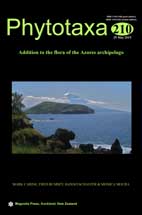Abstract
The taxonomic status of the Azorean endemic Viburnum tinus subsp. subcordatum is reassessed, using morphological characters and new molecular data from the ITS region and the trnK intron. A survey of morphological variation supports the recognition of V. tinus subsp. subcordatum as distinct from V. tinus subsp. tinus and the Canary endemic V. rugosum (formerly known as V. tinus subsp. rigidum) based on leaf shape, the shape of the leaf base and apex, the sub-entire and revolute leaf margins, blistered upper leaf surfaces, trichome density and type, and fruit size. Molecular data also confirm this distinctiveness within section Tinus. Taken together, our morphological and genetic data presented in this paper support the recognition of the Azorean taxon at the species level under the name of Viburnum treleasei. A description of the species is provided and nomenclatural issues relating to the two Macaronesian Viburnum taxa are discussed.

